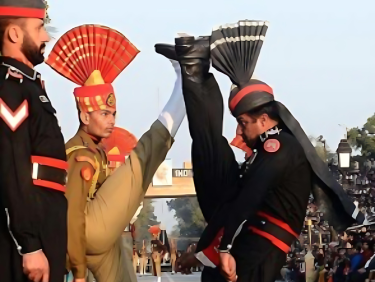Research concept
In an era marked by increasing polarization within and between societies and nations, studies on the nature, expressions, and forms of enmity have become an urgent societal concern. Processes of “enemization” (M. Edelman) threaten peace within and between societies in many parts of the world.
The internet and social media facilitate the rapid spread and radicalization of enemy images and the creation of self-enclosed realities. Neither the intensity nor the contingency of such processes are anything new: Seemingly stable constellations of “hereditary enmity” (Erbfeindschaften) have marked relationships and driven conflicts between intimately linked neighbors throughout history, in Europe and elsewhere. Yet, just as frequently, entrenched hostilities have revealed uncertain identities and struggles to come to terms with paradoxical patterns of fear and latent attraction.

Enmity must be understood as a processual and deeply ambivalent category.
A prime example of such ambivalence toward the enemy is collaboration. Historical research on collaboration in WWII, including collaboration during the Holocaust, provides ample evidence of shifting enemy images, fragile loyalties, and uncertain identities shaped through extended contact in occupied territories and societies. Complex wartime biographies often fail to reveal clear distinctions between collaboration with the enemy and loyalty to the old regime. Instead, they point to situations of “choiceless choice,” moral grey zones, and the confusion of contradictory roles: as victims, followers, resisters, collaborators, and accomplices.
Ambivalent Enmity is designed to explore such ambivalences and develop more adequate tools to analyze the construction, representation, enactment, and experience of enmity. Our goal is to contribute to a theory-guided understanding of the dynamics of antagonism through empirical case studies situated in and between Europe, Asia, and the Middle East from the Middle Ages to the present.

Ambivalent Enmity’s work starts from the premise that enmity must be unequivocally understood as a processual, relational, and profoundly ambivalent category. This allows us to counter simplistic accounts of enmity and the structures along which it is constructed and understood. Certainly, there is plenty to suggest that enmity implies a reduction of complexity. Many theorists have argued that categories such as “nation” or “race” are monolithic cultural constructs that conceal intrinsic variance. In an increasingly interconnected world, as this line of argument claims, enemization emerges as a response to multiplying identities, promising to provide orientation and secure a collective sense of belonging. In consequence, images of enemies bear similar features of homogenization or simplification. Populism in particular has been shown to bring together manifold claims under a common umbrella, establishing a chain of equivalence and construing an “empty signifier.” One of the most powerful of these empty signifiers is the identification of clear-cut, tangible, and invariably oversimplified enemies.
Without denying the merits of such accounts, the historically and regionally saturated studies Ambivalent Enmity envisions are poised to show that despite—or precisely because of—such reductions of complexity, relations of enmity generate highly complex linkages. Knowledge production about alleged enemies, for instance, is frequently driven by a hidden fascination, and often seeks to explore and emulate the enemy’s hidden sources of strength. It is paradoxical linkages such as these that need to be uncovered and deciphered to do justice to the ambivalences of enmity. We will demonstrate that, explicit declarations to the contrary notwithstanding, representations of enmity draw on shared symbolic resources, and we will also show that the emotional responses enmity provokes are as complex as the chains of action it brings about and the contact scenarios in which it develops. Our studies thus aim to test the hypothesis that it is ambivalence, rather than reduction, that plays the decisive role in shaping constellations of enmity.
We aim to substantiate the key hypothesis that enmity must be understood as a processual and deeply ambivalent category. Existing research from fields such as peace and conflict studies, sociology, international law, and anthropology often conceives of enmity as a conflict between self-contained actors. Our goal is to complement this understanding by harnessing our extensive expertise in historical and regional studies and by drawing on fields as varied as postcolonial theory, transcultural studies, studies of social identity, psychological research, and the history of emotions.
REsearch Fields
Ambivalent Enmity pursues this agenda in three Research Fields that will trace the ambivalences of enmity through concrete case studies dedicated to knowledge production (Research Field “Knowing the Enemy”), representation (Research Field “Staging Enmity”), and physical encounters (Research Field “Enemy Contact”). Focusing on the dynamics of exploring, staging, and facing the enemy throws the processual, relational, and ambivalent nature of enmity into sharp relief: Knowing the enemy can create paradoxical effects of cultural learning that transcend purposes of creating propagandistic effects or gathering intelligence; staging enmity necessarily entails imagining and reproducing the views and intentions of the opponent, if only in its most demonized form; and enemy contact creates interpersonal and transcultural relationships with at times unruly consequences that may result in hybridization rather than the originally desired or feared segregation.
The phenomena investigated in the three Research Fields are interlinked via a feedback loop (see Fig. 1) that reflects the emergence, solidification, and transformation of enmity and its ambivalences. Experiences of hostility drive the generation of knowledge about real or perceived enemies; knowledge is mediated in representations of antagonistic relationships; and these representations of enmity in turn shape individual and institutional actors’ attitudes, perceptions, and behavior in future encounters. Ambivalences arise at every stage of this process; without them, so-called “enmity entrepreneurs” would not need to work so persistently to multiply grievances, bolster suspicions, suppress uncertainties, streamline narratives, and spread reductive images. A comprehensive understanding of the dynamics of antagonism in the past and present needs to consider all three of these thematic foci and determine their specific significance for individual case studies.



